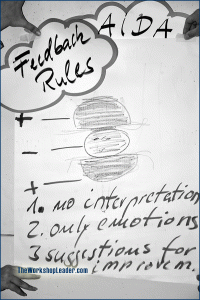You have understood what all great painters understand: in order to forget the rules, you must know them and respect them.
Paul Coelho (*1947)
Brazilian Novelist
A trusting environment is necessary to reach your workshop objectives. Therefore, participants need to feel secure. A set of basic rules and regulations helps overcome initial insecurity. It is important you clarify these rules, give guidance and behave as a role model. Here are a few basic rules to establish early on:
- Everyone has an equal right to speak.
- Every opinion is equally important.
- Disturbances have priority over your plan.
- Everybody has the right to make mistakes.
- Everybody is responsible.
- Questions have to be asked — and answered.
- KISS — especially when making comments.
- Don’t use phrases, which poison the atmosphere or undermine the confidence of other participants. An example would be, ‘That’s the most stupid thing I’ve ever heard.’
- Fun is a key ingredient.
Follow the basic rules
While these are the basic rules, the moderators should encourage the group to contribute a few points of their own, e.g. how to deal with mobile phones.
When these rules have been outlined, you should begin the moderation by explaining to the participants that they should:
- Follow the rules (either the rules that you have suggested or those which you have worked out jointly in the group).
- Share the responsibility for the success of the moderation, as moderation is guided group work.
Keep an open mind throughout. Make it clear when the group is feeling concerned or offended so that the group can solve the issue. Accept that a moderator is not an expert on a specific topic. For additional basic guidelines see the Rules and Regulations.
Transparency
A basic principle of moderation is transparency. This creates trust and security within a group. It enables the group to engage in a self-determined and concentrated way. If everything runs smoothly no one will notice transparency, but if something is opaque it will hamper the process and may even lead to complete refusal of the group to participate.
Transparency refers to four different aspects of a workshop:
1. Transparency in content
All information must be available to participants. They need to know what will be covered and when. In order to clarify expectations, it is recommended to have a moderated and meta-plan session [see Moderation Techniques] on expectations at the beginning. You can refer to it at the end and show which topics have been covered.
During a workshop the content should be clearly structured, easy to orientate (don’t forget headings and subheadings!) and presented in legible handwriting. If you cover topics only verbally, it does not allow you to return to them very easily.
2. Transparency in process
To ensure full participation and engagement, participants should know why they are working on a topic (if you introduce an unexpected topic, you should clarify it thereafter) and when it’s their turn.
A programme for the session is an absolute necessity. We recommend that you provide a printout version on a wall or a door of the seminar room as some participants might have left the programme at home or lost it entirely. It’s also advisable to go through the programme with the group at the beginning of the session.
For any actions, be it a game or group work, clear tasks are required. You should let participants know when and why they are doing an activity, and what it is for. But be aware that giving too many instructions can be confusing.
3. Transparency in behavior
Mostly participants won’t address this by themselves, but everybody is insecure in an unknown environment with new people. Where am I? What is expected from me? How do I behave correctly?
You can reduce this insecurity through transparency. In written communications — the invitation and the programme — you can set out what is expected from participants in terms of dress code and the language of the session. Verbally addressing the group at the beginning of a session clarifies expected behaviour, such as the above-mentioned rules and regulations. Other communication is non-verbal. For example, arrangements in a seminar room (seating in circle or frontal) suggest to the participants how they should behave. The way in which the moderator engages with the participants is also vital. You should ask yourself how you come across to the group: do you sit elevated behind a desk and direct the audience from afar or do you behave more intimately, moving around and engaging with the audience at close quarters.
4. Transparency in disturbances
Equal participation requires that every single participant feels welcomed and comfortable. When you identify a disturbance in the group, this should be dealt with swiftly [see Dealing with disturbances]. The resolution of disturbances should take priority and in most cases they should be addressed openly so that they can be ended with a clear agreement between all participants.


